belt Lexus IS250 2006 Using the audio system / LEXUS 2006 IS350/250 THROUGH APRIL 2006 PROD. (OM53508U) Owner's Guide
[x] Cancel search | Manufacturer: LEXUS, Model Year: 2006, Model line: IS250, Model: Lexus IS250 2006Pages: 433, PDF Size: 10.9 MB
Page 97 of 433
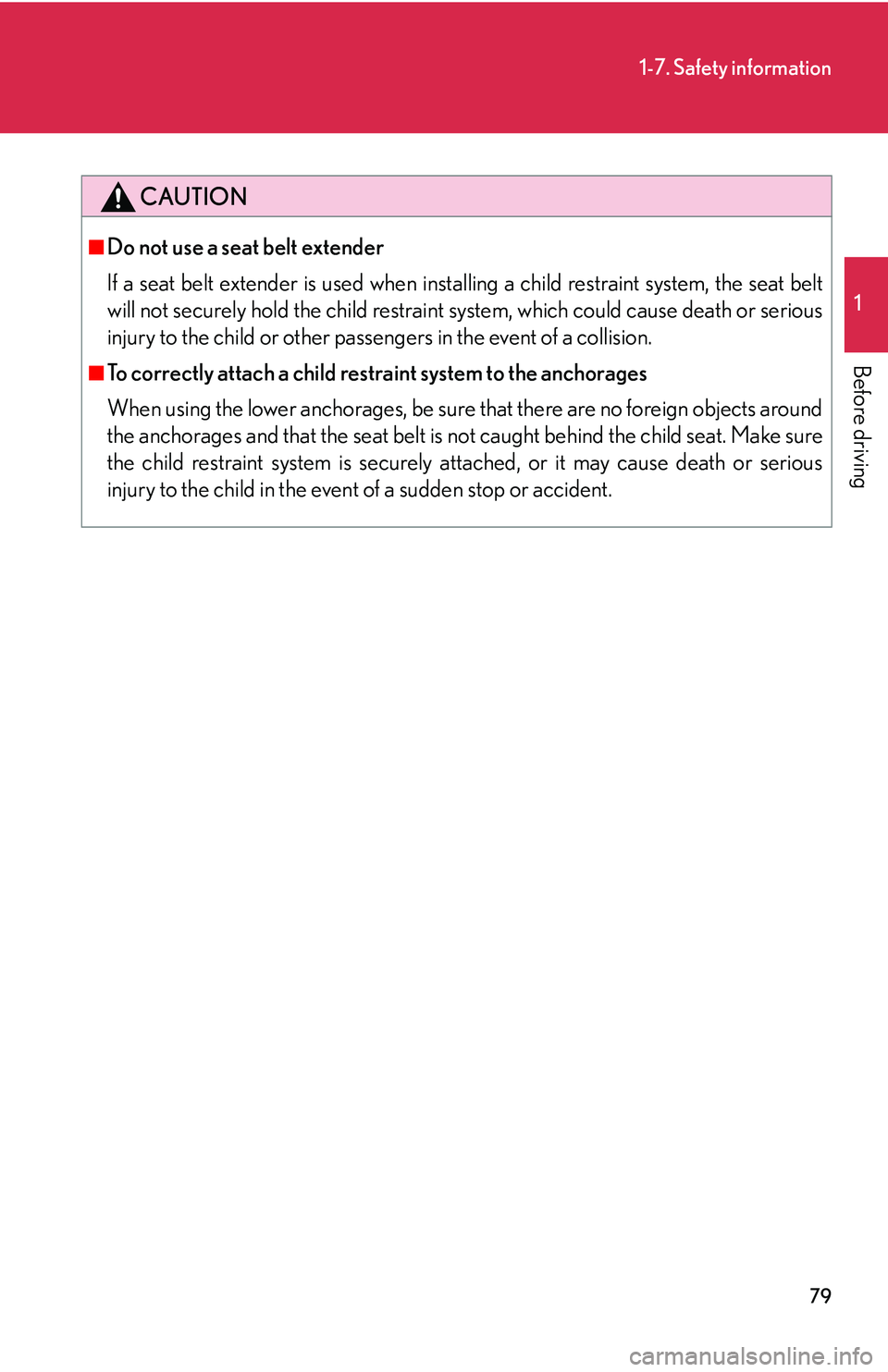
79
1-7. Safety information
1
Before driving
CAUTION
■Do not use a seat belt extender
If a seat belt extender is used when installing a child restraint system, the seat belt
will not securely hold the child restraint system, which could cause death or serious
injury to the child or other passengers in the event of a collision.
■To correctly attach a child restraint system to the anchorages
When using the lower anchorages, be sure that there are no foreign objects around
the anchorages and that the seat belt is not caught behind the child seat. Make sure
the child restraint system is securely at tached, or it may cause death or serious
injury to the child in the even t of a sudden stop or accident.
Page 162 of 433
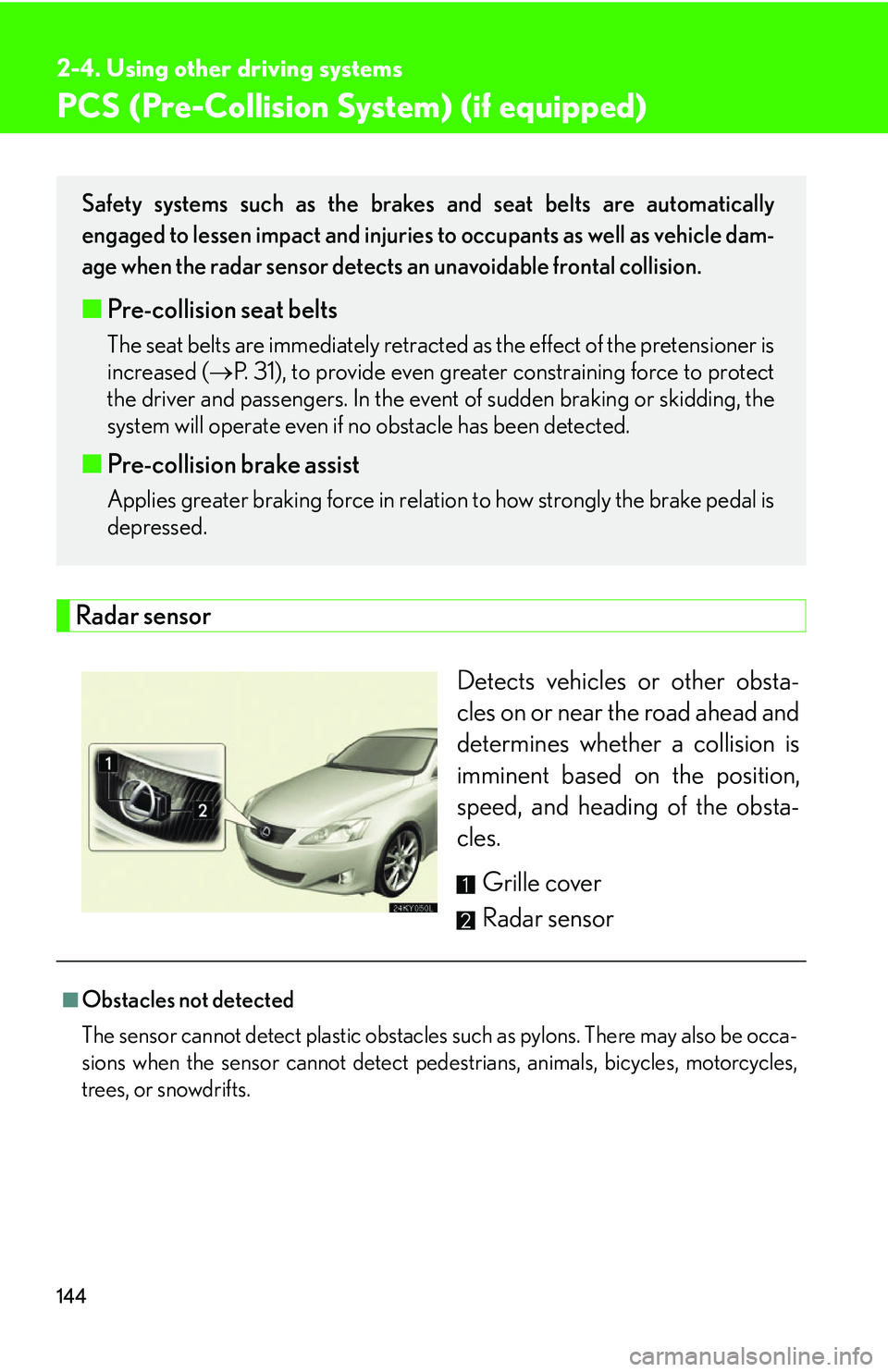
144
2-4. Using other driving systems
PCS (Pre-Collision System) (if equipped)
Radar sensorDetects vehicles or other obsta-
cles on or near the road ahead and
determines whether a collision is
imminent based on the position,
speed, and heading of the obsta-
cles. Grille cover
Radar sensor
Safety systems such as the brakes and seat belts are automatically
engaged to lessen impact and injuries to occupants as well as vehicle dam-
age when the radar sensor detects an unavoidable frontal collision.
■Pre-collision seat belts
The seat belts are immediately retracted as the effect of the pretensioner is
increased ( P. 31), to provide even greater constraining force to protect
the driver and passengers. In the event of sudden braking or skidding, the
system will operate even if no obstacle has been detected.
■Pre-collision brake assist
Applies greater braking force in relati on to how strongly the brake pedal is
depressed.
■Obstacles not detected
The sensor cannot detect plastic obstacles such as pylons. There may also be occa-
sions when the sensor cannot detect pedestrians, animals, bicycles, motorcycles,
trees, or snowdrifts.
Page 163 of 433

145
2-4. Using other driving systems
2
When driving
■The pre-collision system is operational when
●Seat belt (linked to the radar sensor)
• Vehicle speed is above 3 mph (5 km/h).
• The speed at which your vehicle is approaching the obstacle or oncomingvehicle exceeds 18 to 24 mph (30 to 40 km/h).
• The front occupants are wearing a seat belt.
●Seat belts (linked to brake operation)
• Vehicle speed exceeds 9 mph (15 km/h).
• The system detects sudd en braking or skidding.
• The front occupants are wearing a seat belt.
●Brake Assist
• Vehicle speed is above 18 mph (30 km/h).
• The speed at which your vehicle is approaching the obstacle or the vehicle is greater than 18 to 24 mph (30 to 40 km/h).
• The brake pedal is depressed.
■Conditions that may trigger the system even if there is no danger of collision
●When there is an object by the roadside at the entrance to a curve
●When passing an oncoming vehicle on a curve
●When driving over a narrow iron bridge
●When there is a metal object on the road surface
●When driving on an uneven road surface
●When passing an oncoming vehicle on a left-turn
●When your vehicle rapidly closes on the vehicle in front
When the system is activated in the situations described above there is also a possi-
bility that the seat belts will retract quickly and the brakes will be applied with a force
greater than normal. When the seat belt is locked in the retracted position, stop the
vehicle in a safe place, release the seat belt and refasten.
■When there is a malfunction in the system
Warning lights and/or warning mess ages will turn on or flash. (P. 3 2 9 , P. 3 3 4 )
Page 248 of 433

230
3-5. Other interior features
Trunk features
■Cargo hooks
Cargo hooks are provided for
securing loose items.
■ Shopping bag hooks
■ First-aid kit storage belt (if equipped)
Loosen
Tighten
Page 249 of 433

231
3-5. Other interior features
3
Interior features
CAUTION
■When the cargo hooks are not in use
To avoid injury, always return the cargo hooks to their positions when they are not in
use.
■ Warning triangle storage belt
Loosen
Tighten
■ Luggage mat
Pull the lever upwards when lift-
ing the luggage mat up.
The lever can be hooked on the
edge of the trunk.
Page 265 of 433
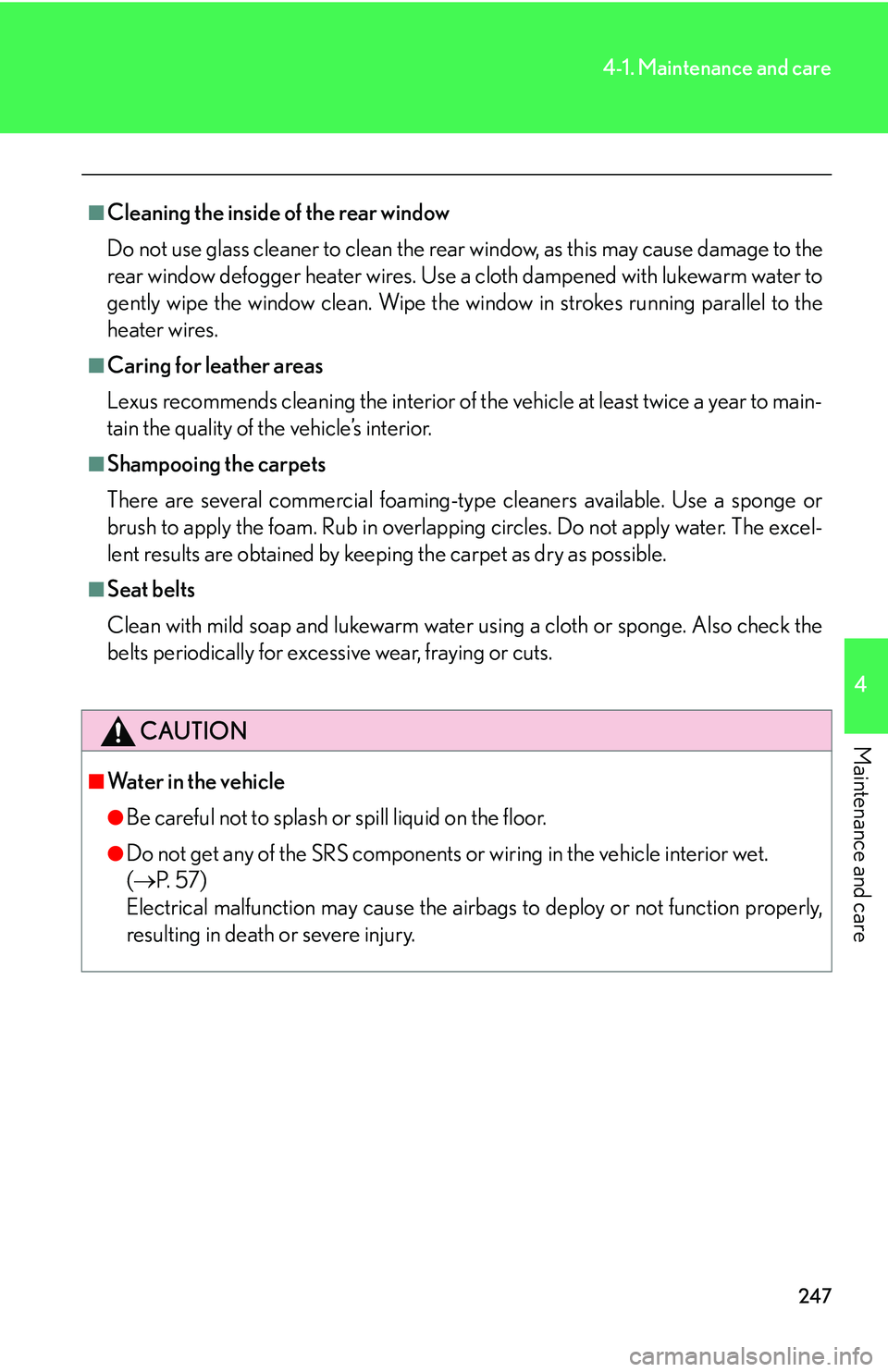
247
4-1. Maintenance and care
4
Maintenance and care
■Cleaning the inside of the rear window
Do not use glass cleaner to clean the rear window, as this may cause damage to the
rear window defogger heater wires. Use a cloth dampened with lukewarm water to
gently wipe the window clean. Wipe the window in strokes running parallel to the
heater wires.
■Caring for leather areas
Lexus recommends cleaning the interior of the vehicle at least twice a year to main-
tain the quality of the vehicle’s interior.
■Shampooing the carpets
There are several commercial foaming-type cleaners available. Use a sponge or
brush to apply the foam. Rub in overlappin g circles. Do not apply water. The excel-
lent results are obtained by keep ing the carpet as dry as possible.
■Seat belts
Clean with mild soap and lukewarm water using a cloth or sponge. Also check the
belts periodically for excessive wear, fraying or cuts.
CAUTION
■Water in the vehicle
●Be careful not to splash or spill liquid on the floor.
●Do not get any of the SRS components or wiring in the vehicle interior wet.
( P. 5 7 )
Electrical malfunction may cause the airbags to deploy or not function properly,
resulting in death or severe injury.
Page 270 of 433

252
4-2. Maintenance
Vehicle interior
ItemsCheck points
Accelerator pedal• Moves smoothly (without uneven pedal effort or catching)?
Automatic transmission “Park”
mechanism• Can the vehicle be hold securely on an incline with the shift lever in
P?
Brake pedal
• Moves smoothly?
• Does it have appropriate clearance and correct amount of free play?
Brakes
• Not pull to one side when applied?
• Loss of brake effectiveness?
• Spongy feeling brake pedal?
• Pedal almost touches floor?
Head restraints• Move smoothly and lock securely?
Indicators/buzzers• Function properly?
Lights
• Do all the lights come on?
• Headlights aimed correctly? ( P. 3 0 9 )
Pa r k i n g b r a ke
• Moves smoothly?
• Can hold the vehicle securely on
an incline?
Seat belts
• Does the seat belt system operate smoothly?
• Are the belts undamaged?
Seats• Do the seat controls operate prop- erly?
Page 274 of 433
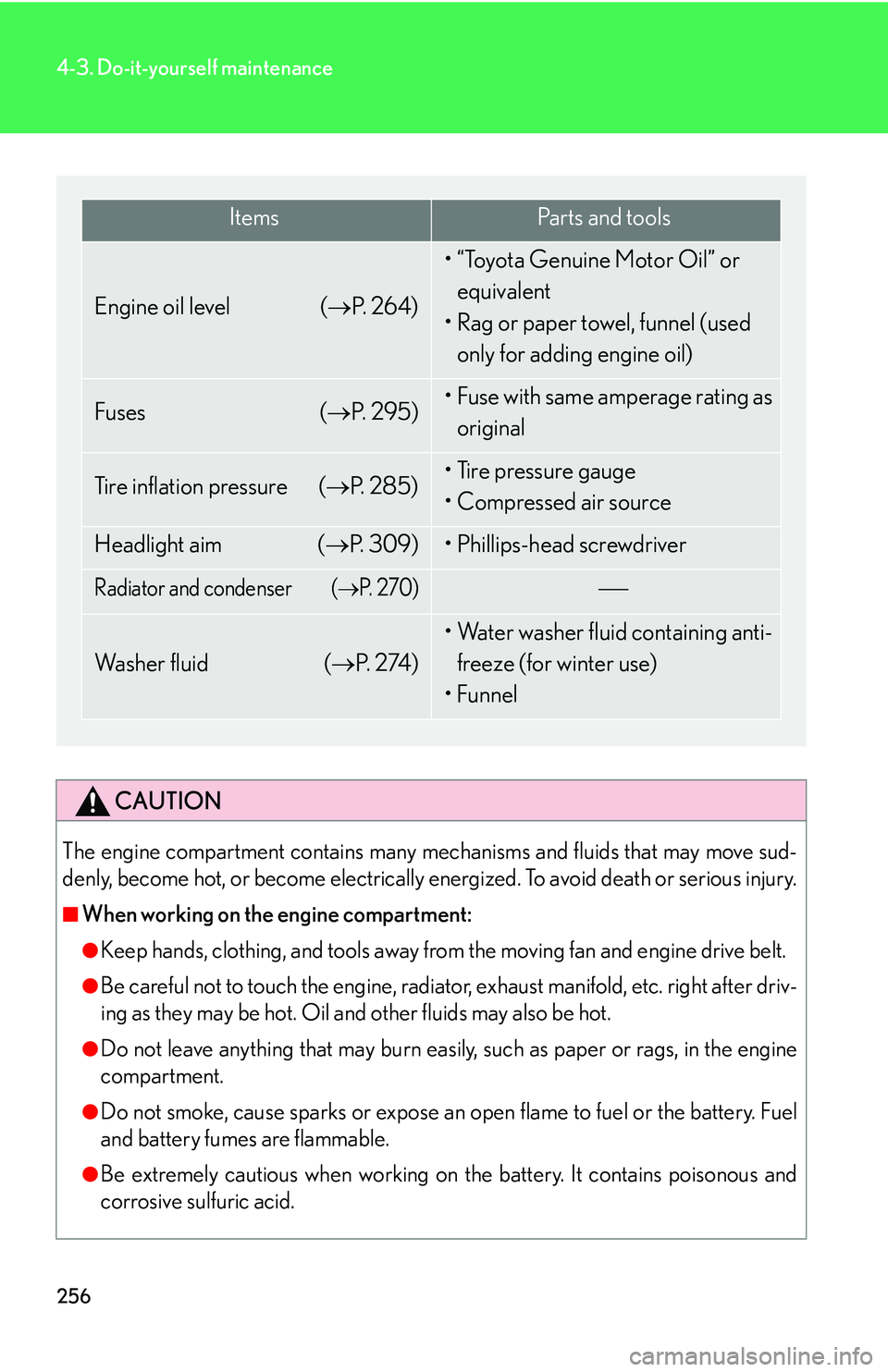
256
4-3. Do-it-yourself maintenance
CAUTION
The engine compartment contains many mechanisms and fluids that may move sud-
denly, become hot, or become electrically energized. To avoid death or serious injury.
■When working on the engine compartment:
●Keep hands, clothing, and tools away from the moving fan and engine drive belt.
●Be careful not to touch the engine, radiator , exhaust manifold, etc. right after driv-
ing as they may be hot. Oil and other fluids may also be hot.
●Do not leave anything that may burn easi ly, such as paper or rags, in the engine
compartment.
●Do not smoke, cause sparks or expose an open flame to fuel or the battery. Fuel
and battery fumes are flammable.
●Be extremely cautious when working on the battery. It contains poisonous and
corrosive sulfuric acid.
ItemsPa r t s a n d t o o l s
Engine oil level ( P. 2 6 4 )
• “Toyota Genuine Motor Oil” or
equivalent
• Rag or paper towel, funnel (used only for adding engine oil)
Fuses ( P. 2 9 5 )• Fuse with same amperage rating as
original
Tire inflation pressure ( P. 2 8 5 )• Tire pressure gauge
• Compressed air source
Headlight aim ( P. 3 0 9 )• Phillips-head screwdriver
Radiator and condenser (P. 2 7 0 )
Wa s h e r f l u i d ( P. 2 74 )
• Water washer fluid containing anti-
freeze (for winter use)
•Funnel
Page 301 of 433
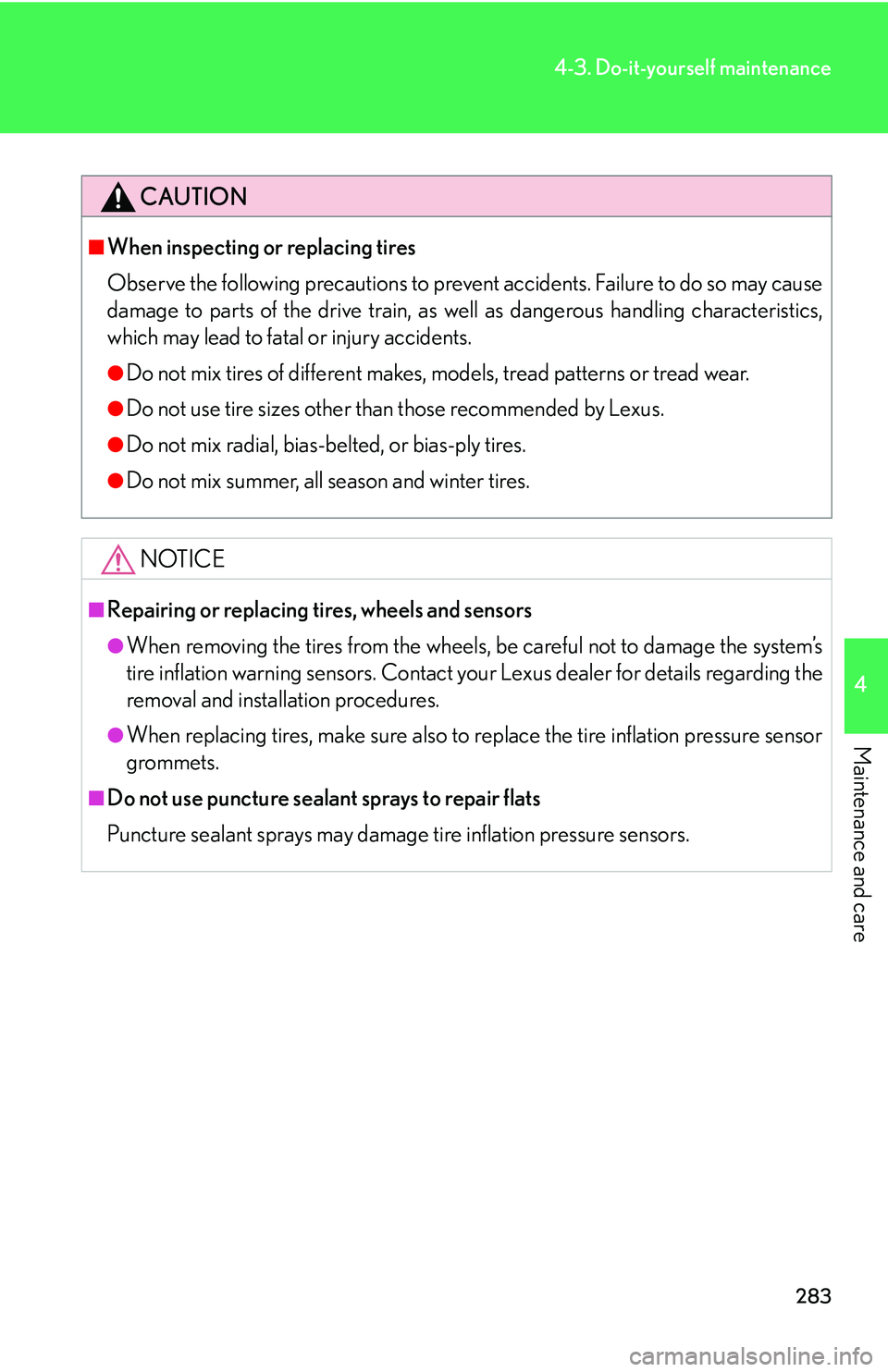
283
4-3. Do-it-yourself maintenance
4
Maintenance and care
CAUTION
■When inspecting or replacing tires
Observe the following precautions to prevent accidents. Failure to do so may cause
damage to parts of the drive train, as well as dangerous handling characteristics,
which may lead to fatal or injury accidents.
●Do not mix tires of different makes, models, tread patterns or tread wear.
●Do not use tire sizes other than those recommended by Lexus.
●Do not mix radial, bias-belted, or bias-ply tires.
●Do not mix summer, all season and winter tires.
NOTICE
■Repairing or replacing tires, wheels and sensors
●When removing the tires from the wheels, be careful not to damage the system’s
tire inflation warning sensors. Contact your Lexus dealer for details regarding the
removal and installation procedures.
●When replacing tires, make sure also to replace the tire inflation pressure sensor
grommets.
■Do not use puncture sealant sprays to repair flats
Puncture sealant sprays may damage tire inflation pressure sensors.
Page 322 of 433

304
4-3. Do-it-yourself maintenance
■Driver’s side instrument panel
FuseAmpereCircuit
1FR P/SEAT LH30APo w e r s e a t
2A/C7. 5 AAir conditioning system
3MIR HTR15AOutside rear view mirror defoggers
4TV NO.110ADisplay
5FUEL OPEN10AFuel filler door opener
6TV NO.27. 5 A
7PSB30APre-collision seat belt
8S/ROOF25AElectric moon roof
9TA I L10ATail lights, license plate lights, parking
lights
10PA N E L7. 5 ASwitch illumination, air conditioning
system, display
11RR FOG7. 5 A
12ECU-IG LH10A
Cruise control, air conditioning sys-
tem, power steering, rain sensor, anti-
glare inside rear view mirror, shift lock
system, moon roof, tire inflation pres-
sure warning system
13FR S/HTR LH15ASeat heaters and ventilators